Japanese Barberry Berberis thunbergii f. atropurpurea 'Dart's Red Lady'

ABOUT
The plant commonly known as 'Dart's Red Lady' is a cultivar of Japanese barberry that is distinctly characterized by its striking foliage and thorny branches. The leaves of this particular variety showcase a deep reddish-purple hue, creating a dense, richly colored canopy throughout the growing season. In the fall, the foliage may transition to even more intense shades, adding fiery tones to the landscape before the leaves drop. The overall form of the plant is typically dense and compact, with a rounded habit that makes it suitable for shrub borders and foundation plantings. Small, yellow flowers may appear in the spring, creating a subtle contrast against the dark foliage. After flowering, tiny, glossy, red berries develop, providing an additional splash of color and visual interest, as well as food for local birds. The thorns on the branches serve as a deterrent for some creatures but contribute to the plant's distinctive texture. Overall, 'Dart's Red Lady' is appreciated for its vibrant foliage, seasonal color changes, and its versatility in various garden designs, where it adds both aesthetic appeal and a measure of defense against browsing animals.
About this plant
 Names
NamesFamily
Berberidaceae.
Synonyms
Japanese Barberry, Red Barberry, Purple-leaved Japanese Barberry, Dart's Red Lady Barberry.
Common names
Berberis thunbergii var. atropurpurea 'Dart's Red Lady'.
 Toxicity
ToxicityTo humans
Japanese barberry, including the variety Berberis thunbergii f. atropurpurea 'Dart's Red Lady', is not considered highly toxic to humans. However, consuming the berries in large quantities may cause mild upset stomach, nausea, vomiting, or diarrhea. The plant's spines can also cause physical injury if not handled properly. It is advisable to avoid ingesting any part of the plant and to wear gloves and protective clothing when handling it to prevent potential skin punctures or scratches.
To pets
Japanese barberry, including the variety Berberis thunbergii f. atropurpurea 'Dart's Red Lady', is not highly toxic to pets, but it can cause gastrointestinal upset if ingested. Symptoms of poisoning could include vomiting, diarrhea, and lethargy. Additionally, the sharp thorns on the plant can cause physical injuries, such as scratches or puncture wounds. It's best to keep pets away from the plant to avoid accidental ingestion or injury.
 Characteristics
CharacteristicsLife cycle
Perennials
Foliage type
Deciduous
Color of leaves
Purple
Flower color
Yellow
Height
4 feet (1.2 meters)
Spread
4 feet (1.2 meters)
Plant type
Shrub
Hardiness zones
4
Native area
Japan
Benefits
 General Benefits
General Benefits- Landscape Aesthetics: This variety of Japanese barberry offers year-round visual interest with its purple or reddish-purple foliage and its small red berries.
- Low Maintenance: Japanese barberry is known for its low maintenance requirements, being drought-tolerant and requiring minimal care once established.
- Tolerance to Conditions: It is adaptable to a wide range of soil types and can tolerate urban pollution, making it suitable for urban landscapes.
- Seasonal Interest: Offers a splash of color in autumn as the leaves turn vibrant shades of orange, red, and yellow.
- Wildlife Attraction: The berries produced by the plant can attract birds and other wildlife to a garden.
- Privacy and Security: The thorny nature of this shrub can contribute to a security hedge or privacy screen in landscaping.
- Erosion Control: Its dense growth habit helps in stabilizing soil and preventing erosion on slopes.
 Medical Properties
Medical Properties- This plant is not used for medical purposes.
 Air-purifying Qualities
Air-purifying QualitiesThis plant is not specifically known for air purifying qualities.
 Other Uses
Other Uses- Japanese barberry can be used to create natural dyes owing to its vivid foliage, particularly for textile artwork or natural craft projects.
- Due to its dense growth, the plant may serve as a noise buffer in landscapes close to busy streets.
- Japanese barberry's thorny branches can be used as a protective barrier against small animals when planted around sensitive areas like vegetable gardens.
- The wood of the Japanese barberry, being hard and durable, can be utilized in small woodworking projects such as carving or for making tool handles.
- The plant can act as a windbreak in gardens, protecting other more sensitive plants from strong winds.
- Japanese barberry's varied-colored foliage provides excellent material for creating decorative wreaths and other floral arrangements.
- In landscape design, the plant can be utilized to create a textured contrast with other plants due to its unique purple leaves.
- The plant’s berries can be used as feed for birds, thus contributing to supporting local wildlife habitats.
- Japanese barberry can be shaped into living sculptures or topiaries in ornamental gardens, making use of its dense branching.
- The plant can be used as a living fence or hedge that provides privacy throughout the year due to its thick foliage.
Interesting Facts
 Feng Shui
Feng ShuiThe Japanese Barberry is not used in Feng Shui practice.
 Zodiac Sign Compitability
Zodiac Sign CompitabilityThe Japanese Barberry is not used in astrology practice.
 Plant Symbolism
Plant Symbolism- Intrigue: The intricate branches and deep red-purple foliage of the Japanese barberry may symbolize life's complex beauty.
- Protection: Barberries have thorns that act as a natural barrier, representing safeguarding and setting personal boundaries.
- Adaptability: Given the hardiness and adaptability of the Japanese barberry to different soil types and environments, it can signify resilience and flexibility.
- Balance: The Japanese barberry's attractive appearance throughout different seasons symbolizes balance and constancy in life.
 Water
WaterThe Japanese Barberry, commonly known as the Red Barberry, should be watered deeply but infrequently to mimic natural rainfall, allowing the soil to dry slightly between waterings. For newly planted shrubs, water with about 2 gallons per week for the first growing season. Established plants require less frequent watering, depending on weather conditions, usually every two weeks if there hasn't been substantial rainfall. During hot, dry spells, you may need to increase watering to once a week, ensuring the plant receives at least 1.5 to 2 gallons each time to keep the soil moist but not waterlogged.
 Light
LightThe Red Barberry thrives in full sun to partial shade. It is most colorful when planted in a spot that receives at least 6 hours of direct sunlight per day, but it can also tolerate light shade. Avoid deep shade as it can lead to poor foliage color and reduced density.
 Temperature
TemperatureThe Red Barberry is hardy and adapts well to a range of temperatures. It can withstand winter temperatures as low as -30°F and is comfortable during the summer heat up to 100°F. The ideal temperature range for this plant is between 60°F and 70°F for optimal growth and foliage color.
 Pruning
PruningPrune the Red Barberry to maintain its shape and density, and to remove any dead or damaged branches. The best time for pruning is late winter to early spring before new growth starts. Thin out crowded branches every few years to allow light and air to penetrate the plant, which encourages healthy growth. Regular pruning also helps to control the size of the shrub and can stimulate more vibrant foliage color.
 Cleaning
CleaningAs needed
 Soil
SoilThe Japanese Barberry, prefers well-drained, loamy soil with a pH range of 5.5 to 7.5. A mix of garden soil, compost, and peat moss or a balanced soil mix designed for shrubs is ideal, ensuring good aeration and nutrient availability.
 Repotting
RepottingJapanese Barberry doesn't need frequent repotting; do it every 2-3 years or if you notice substantial root crowding. Spring is the best time to repot and give room for growth.
 Humidity & Misting
Humidity & MistingJapanese Barberry is adaptable to a range of humidity levels and typically does well in average outdoor humidity without special attention to modifying conditions for most residential settings.
 Suitable locations
Suitable locationsIndoor
Bright light, cool temps, and moderate watering suit indoor Japanese Barberry.
Outdoor
Full sun to part shade, adaptable to soil types but drains well for outdoor Japanese Barberry.
Hardiness zone
4-8 USDA
 Life cycle
Life cycleBerberis thunbergii f. atropurpurea 'Dart's Red Lady', commonly known as Japanese Barberry 'Dart's Red Lady', starts its life from seed germination, which takes place in moist, well-drained soil typically in early spring. The seedling then develops into a young shrub with the characteristic reddish-purple foliage. As it enters the vegetative growth stage, the plant experiences rapid growth in both root and shoot systems during spring and summer. During this period, it develops sharp spines along its branches and may produce small, yellow flowers in late spring followed by bright red berries in the summer. The plant reaches maturity in several years, capable of producing its own seeds to perpetuate the life cycle. In winter, Japanese Barberry 'Dart's Red Lady' becomes dormant, losing its leaves in colder climates, but the stems and spines remain, allowing for survival through the winter months until the cycle begins anew with the return of warmer weather.
 Propogation
PropogationPropogation time
Late winter to early spring
Propogation: The most popular method of propagating the Japanese barberry 'Dart's Red Lady' is through softwood cuttings. This is typically done in late spring to early summer when new growth is still green and flexible. Cuttings should be about 4 to 6 inches (10 to 15 cm) long and include several leaf nodes. The lower leaves are removed and the cut end dipped in rooting hormone before being placed in a well-draining potting mix. High humidity and indirect light help the cutting take root over the course of a few weeks, after which it can be transplanted to a larger container or directly to the garden location.

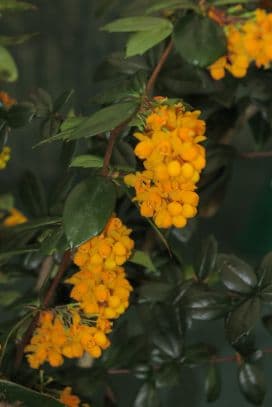
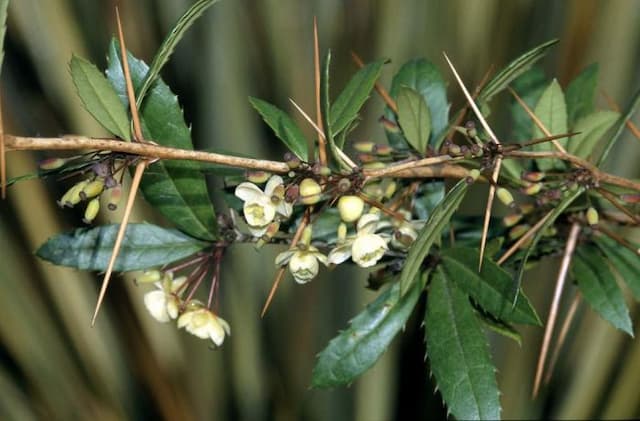
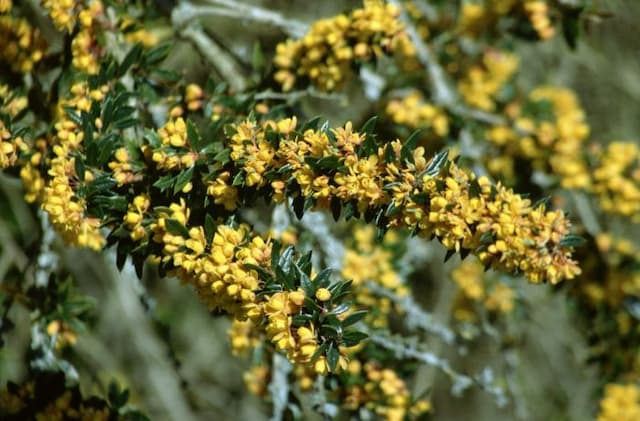

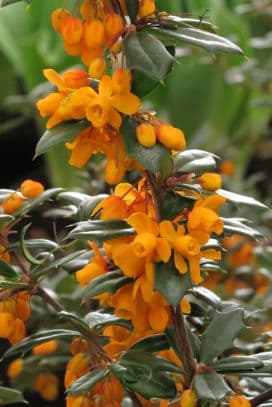
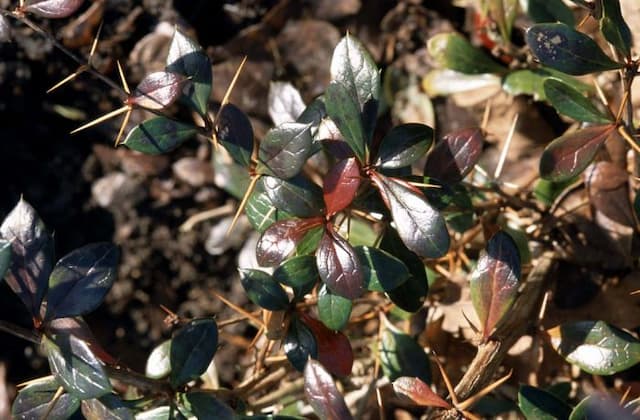


![Japanese barberry [Bonanza Gold]](/_next/image?url=https%3A%2F%2Fplants-admin.emdemapps.com%2Fimages%2Fplants%2F%2Fimages%2F604b5385e413f.png&w=640&q=75)